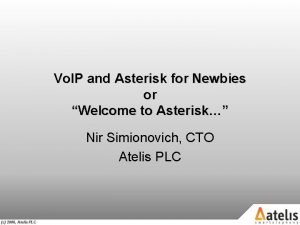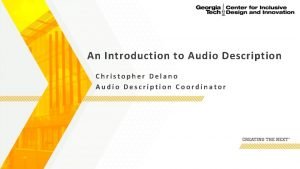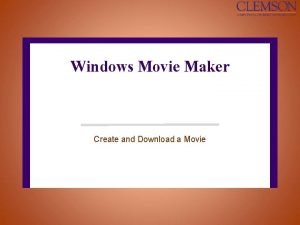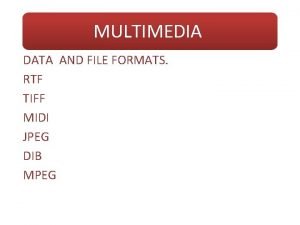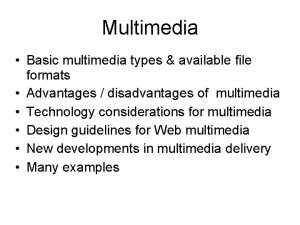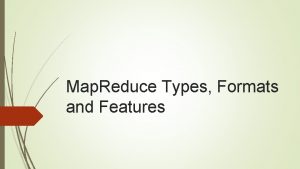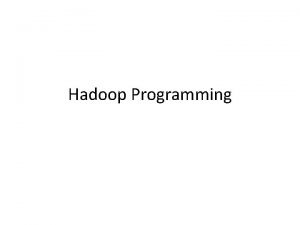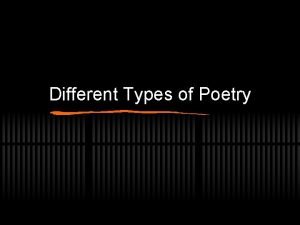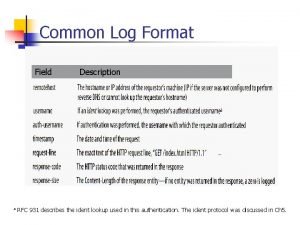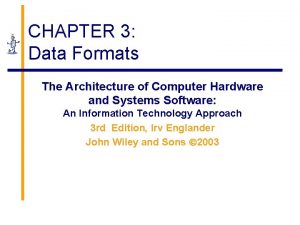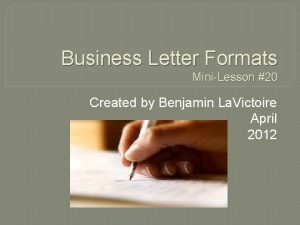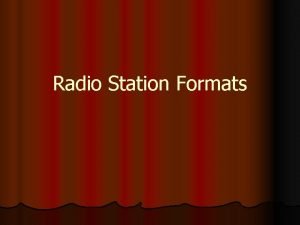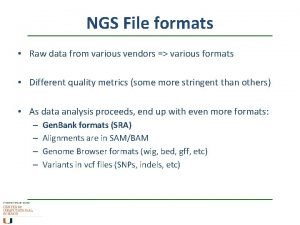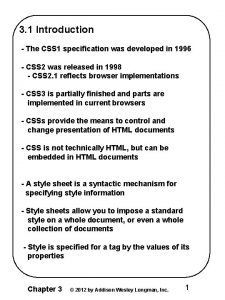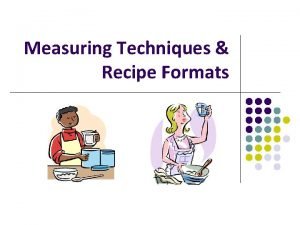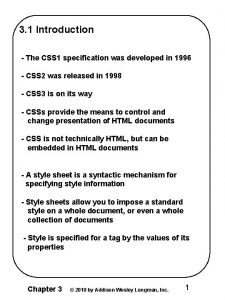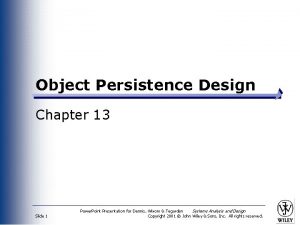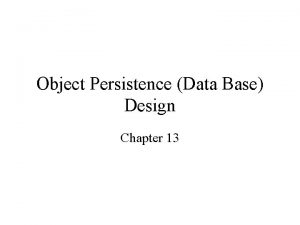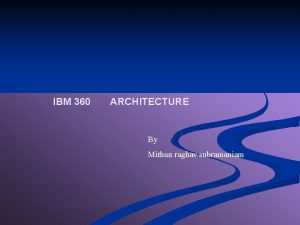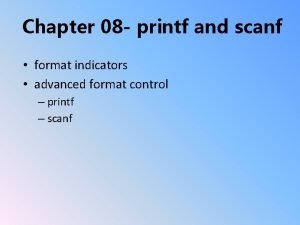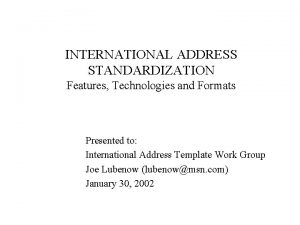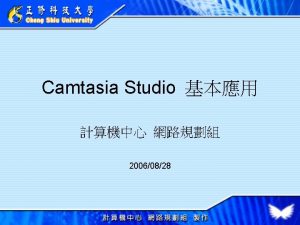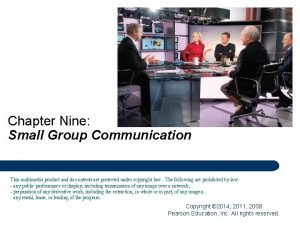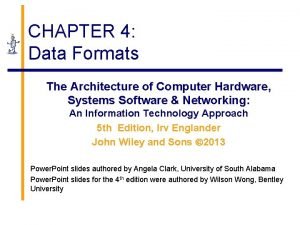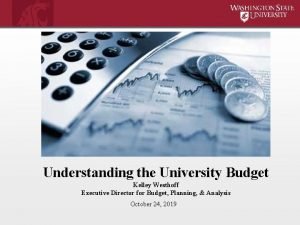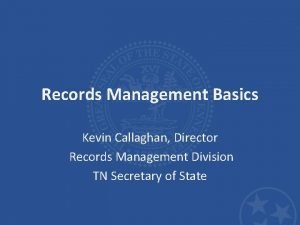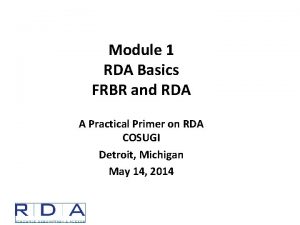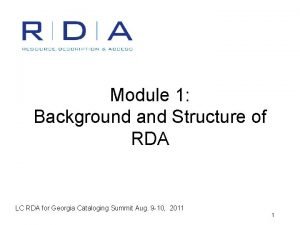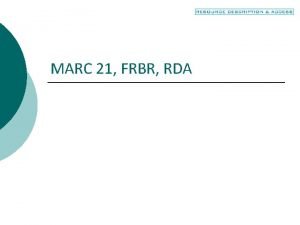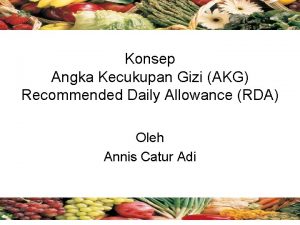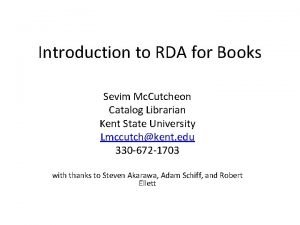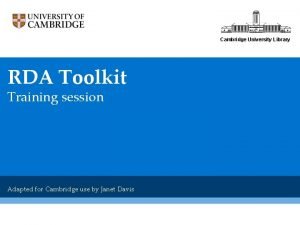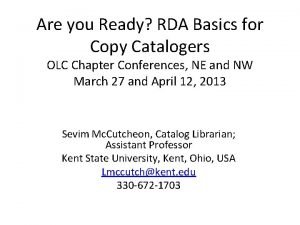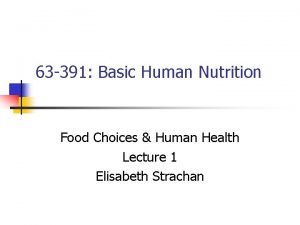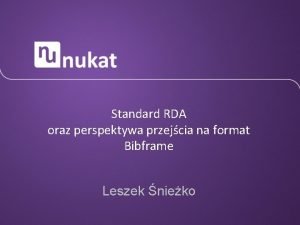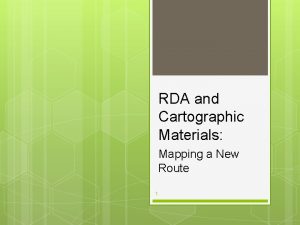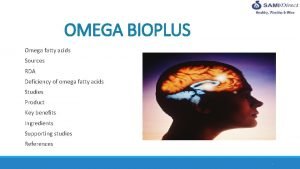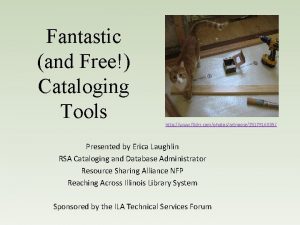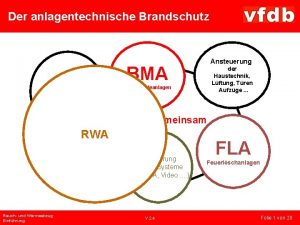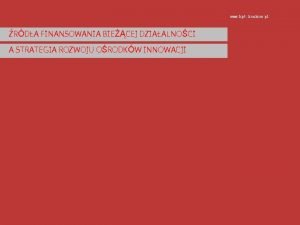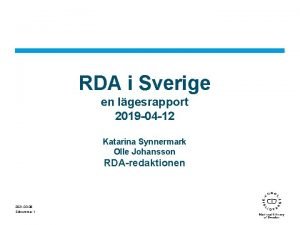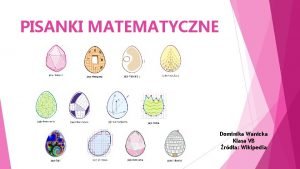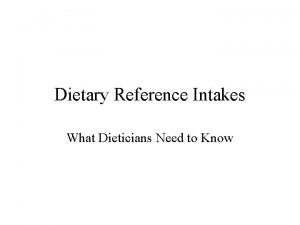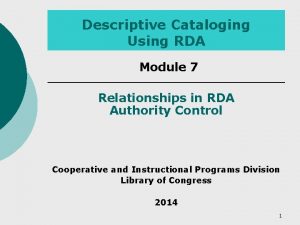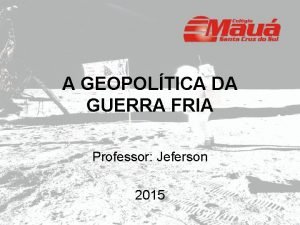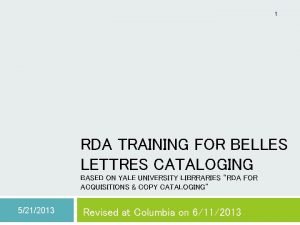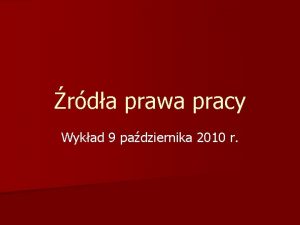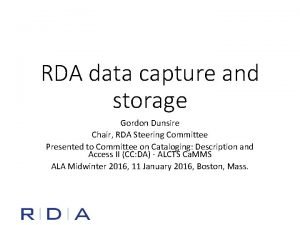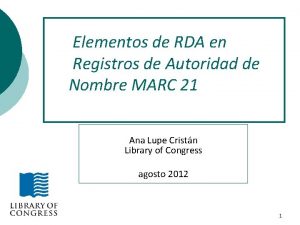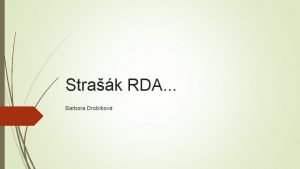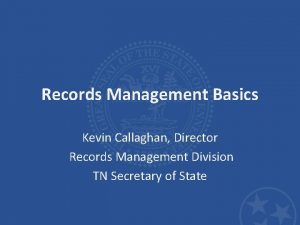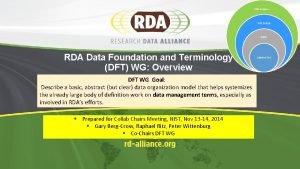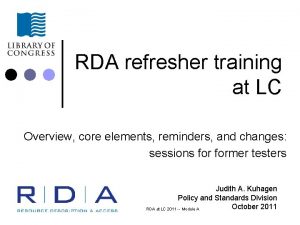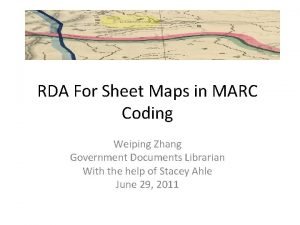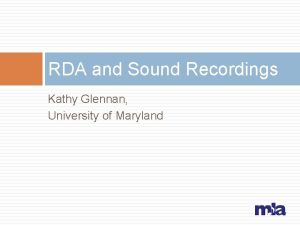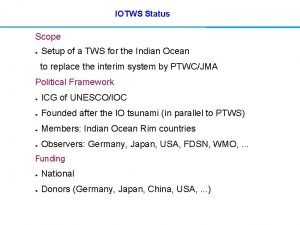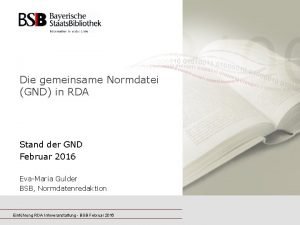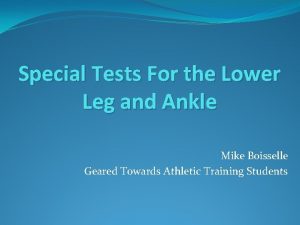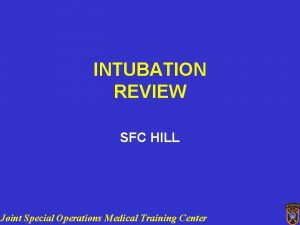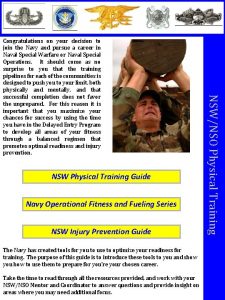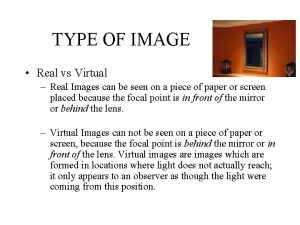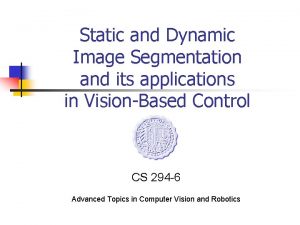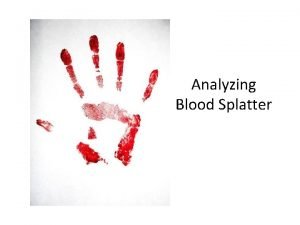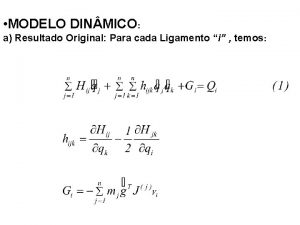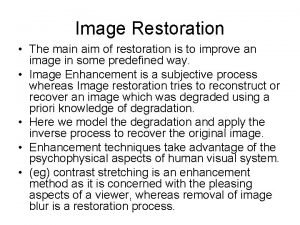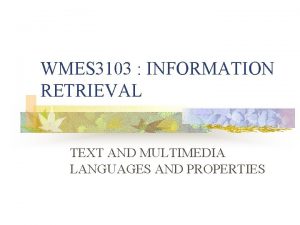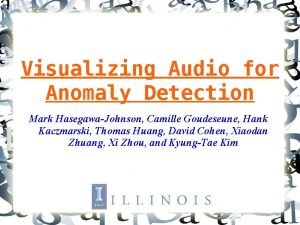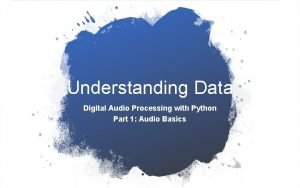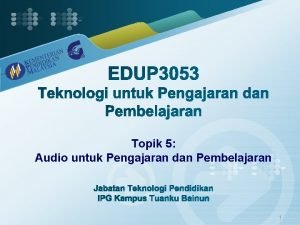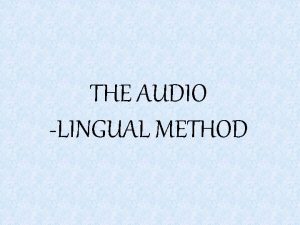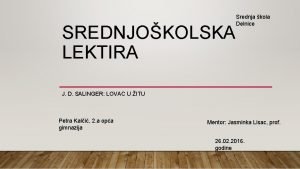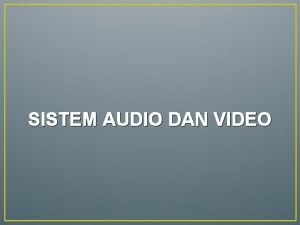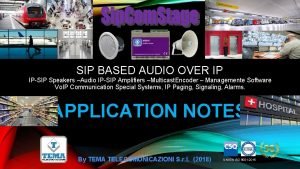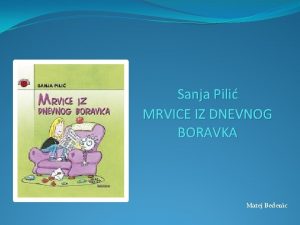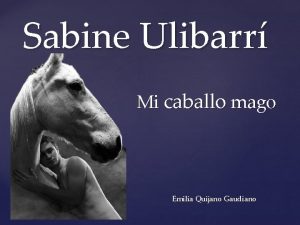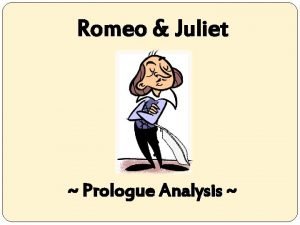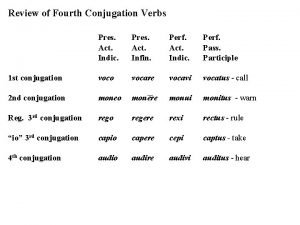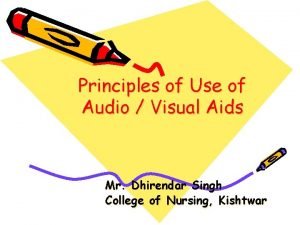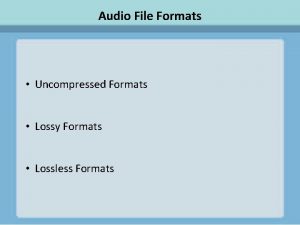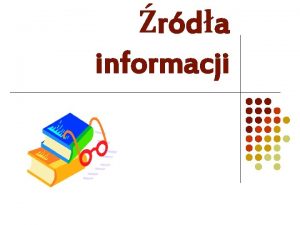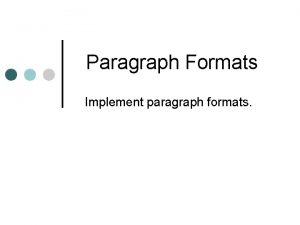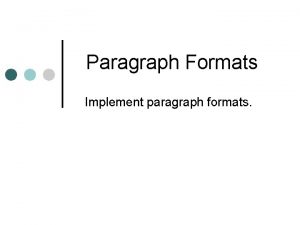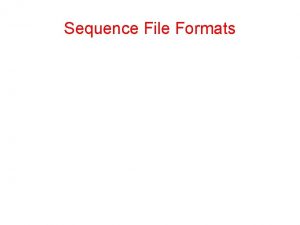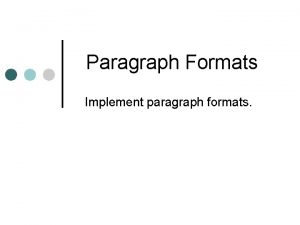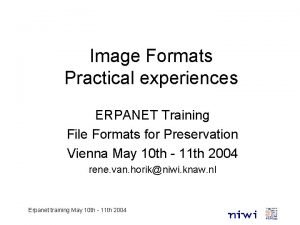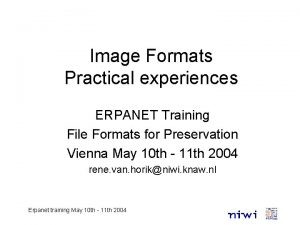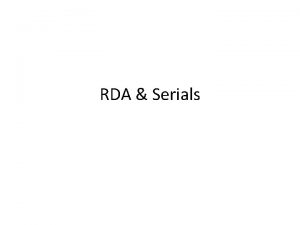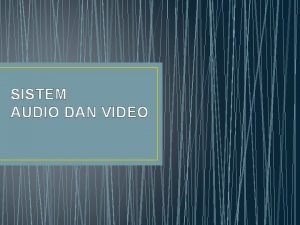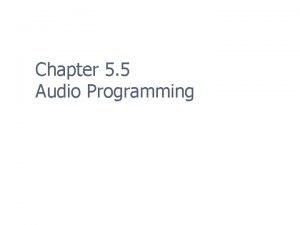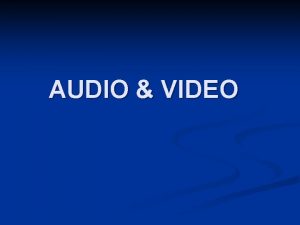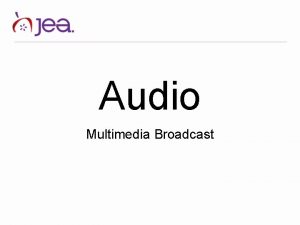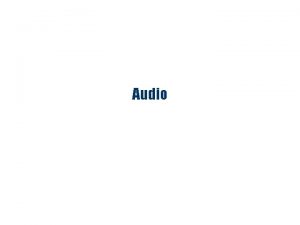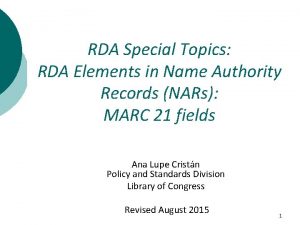RDA SPECIAL FORMATS TRAINING MOVING IMAGE RECORDINGS AUDIO




































![RDA AND MOVING IMAGE MATERIALS Before [AACR 2]: 300 ## 1 videodisc (92 min. RDA AND MOVING IMAGE MATERIALS Before [AACR 2]: 300 ## 1 videodisc (92 min.](https://slidetodoc.com/presentation_image_h2/549502519e65f77d292555163133c944/image-37.jpg)


















































































- Slides: 119

RDA: SPECIAL FORMATS TRAINING MOVING IMAGE RECORDINGS AUDIO RECORDINGS NOTATED MUSIC Presentation compiled by Jim SOE NYUN and held at UC San Diego on March 14, 2013 (Rev 8)

ACKNOWLEDGEMENTS This presentation is informed by several other sessions or resources devoted to cataloging videos, audio recordings and/or musical scores, mainly: Kathy Glennan. RDA and Music Basics. ALCTS webinars. • Scores. October 19, 2011. http: //www. ala. org/alcts/confevents/upcoming/webinar/cat/101911 • Sound Recordings. October 26, 2011. http: //www. ala. org/alcts/confevents/upcoming/webinar/cat/102611 Music Library Association and Music OCLC Users Group. Hit the Ground Running! RDA Training for Music Catalogers. February 27, 2013. http: //guides. library. cornell. edu/content. php? pid=422336&sid=3452843 Music Library Association Southern California Chapter. Cataloging Musical Scores and Sound Recordings Workshop. April 13, 2012. (See Jim Soe Nyun for handouts. ) Stanford University. Videos—Cataloging. http: //lib. stanford. edu/metadata-department/clone-video-catalogingguidelines Jay Weitz. • Sound Cataloging Workshop. OLAC Conference. October, 2012. https: //www. dropbox. com/sh/fbzr 895 ghu 8 yxa 9/dkj 8 J 4 v 7 Iq/Presentation%20 Handouts/Sound. Recording. Workshop 2 012. pptx • Videorecordings Cataloging Workshop. OLAC Conference. October, 2012. https: //www. dropbox. com/sh/fbzr 895 ghu 8 yxa 9/S 3 ag. AHos. LQ/Presentation%20 Handouts/Video. Workshop 2012. pptx

INTENDED AUDIENCE, FOCUS This session is designed for UCSD catalogers who deal with moving image materials, audio recordings, and/or notated music, and is intended to supplement the general RDA training already conducted at UCSD. The focus will mainly be on changes from AACR 2 to RDA. The session is not intended to be a complete guide to cataloging these special materials. It follows many the recommendations of the draft Best Practices for Music Cataloging: http: //bcc. musiclibraryassoc. org/BCCHistorical/BCC 2013/RDA_Best_Practices_for_Music_Cataloging. pdf It incorporates many features of the PCC Bibco Standard Record (BSR): http: //www. loc. gov/aba/pcc/scs/documents/PCC-RDA-BSR. pdf In addition it includes some local policies not covered in the BSR.

DISCLAIMERS 1. Community standards continue to develop, so some of the recommended practices described in this presentation will evolve. 2. The practices described in this presentation derive from a close read of RDA and currently available documentation about cataloging under RDA. Some interpretations may differ from those found in other sources. 3. This presentation won’t be updated to accommodate changes in rules or practice. If you notice any outright errors, however, I welcome corrections at: jsoenyun [at] ucsd [dot] edu

TODAY’S PROGRAM 1. RDA and Moving Image Materials 2. RDA and Audio Recordings 3. RDA and Notated Music 4. Major Changes to Authority Work for Musical Works

1. RDA AND MOVING IMAGE MATERIALS

RDA AND MOVING IMAGE MATERIALS RDA 2. 2. 2 Preferred Source of Information RDA 2. 2. 2. 3 Resources Consisting of Moving Images If the resource consists of moving images (e. g. , a film reel, a videodisc, a video game, an MPEG video file), use the title frame or frames, or title screen or screens, as the preferred source of information. Alternative Use an eye-readable label bearing a title that is permanently printed on or affixed to the resource (excluding accompanying textual material or a container) in preference to the title frame or frames, or title screen or screens. If the resource does not contain a title frame or title screen, use as the preferred source of information, as applicable: either a) a label bearing a title that is permanently printed on or affixed to the resource, excluding accompanying textual material or a container (e. g. , a label on a videodisc) or b) embedded metadata in textual form that contains a title (e. g. , metadata embedded in an MPEG video file). If the resource contains neither a title frame or title screen nor a source of information falling into category a) or b) above, use as the preferred source of information another source forming part of the resource itself, giving preference to sources in which the information is formally presented.

RDA AND MOVING IMAGE MATERIALS Manifestation title (RDA 2. 3) The RDA rules for moving image materials are almost entirely the same as those for other materials as to what information you transcribe. In MARC the information goes into the 245 subfields a, b, n and p. Under RDA, unlike under AACR 2, there is no general material designator. (That function has moved to new areas, content type, media type and carrier type, which will be discussed later. )

RDA AND MOVING IMAGE MATERIALS Statement of Responsibility Relating to Title Proper (RDA 2. 4. 2) RDA 2. 4. 1. 1 states: A statement of responsibility is a statement relating to the identification and/or function of any persons, families, or corporate bodies responsible for the creation of, or contributing to the realization of, the intellectual or artistic content of a resource. For moving image material, however, limit to the 245 subfield c the elements that fit the definition of “Creator” under RDA 19. 2. 1. 1: A creator is a person, family, or corporate body responsible for the creation of a work. For moving image materials, generally assume that directors, producers (including both human producers and corporate production companies) and screenwriters are creators. No more “Rule of Three. ”

RDA AND MOVING IMAGE MATERIALS Title Proper and Statements of Responsibility, examples WVLNT : wavelength for those who don't have the time / Michael Snow Beasts of the southern wild / a Cinereach and Court 13 production, in association with Journeyman Pictures ; produced by Dan Janvey, Michael Gottwald, & Josh Penn ; screenplay by Lucy Alibar & Benh Zeitlin ; directed by Benh Zeitlin Encadenados = Notorious / directed by Alfred Hitchcock ; written by Ben Hecht

RDA AND MOVING IMAGE MATERIALS Authorized Access Point for the Work (RDA 6. 27. 1. 3) Generally follow the exception: Moving image works. For motion pictures, video games, etc. , construct the authorized access point representing the work by using the preferred title for the work (see 6. 2. 2). To break a conflict, follow the instructions in 6. 21. 1. 9 and the associated LC-PCC PS to make your access point unique. Always begin with the form element, “motion picture” or “television program. ” Add other elements as needed. Othello (Television program : 1963 : Canadian Broadcasting Corporation) Othello (Television program : 1963 : WOR-TV (Television station : New York, N. Y. ))

RDA AND MOVING IMAGE MATERIALS More on Authorized Access Point for the Work Appendix 1 of the LCPS for 6. 27. 1. 9 to the rescue: Motion pictures: Same title, different resources, Different titles in the same language, Dubbed motion picture, Motion picture with translated intertitles, Subtitled motion picture released under the same or a different title, Motion picture filmed simultaneously in different languages under different titles, Comprehensive title/Individual title. Television programs: Same title, different resources, Comprehensive title/Individual title, Compilations Plus policies for radio programs And policies for constructing authorized access points for related works or subject access when cataloging any resource related to a motion picture, television program, or radio program

RDA AND MOVING IMAGE MATERIALS Identifier for the Manifestation (RDA 2. 15) The BSR asks you to code for identifiers for the manifestation, and for moving image materials these identifiers are frequently useful. RDA 2. 15. 1. 2: “Take identifiers for the manifestation from any source. ” 020 ## 9780060103217 024 1# 024543824787 028 42 2282478 $b 20 th Century Fox Home Entertainment Use MARC indicators in 028 fields to generate notes when possible.

RDA AND MOVING IMAGE MATERIALS Statements on Production, Publication, Distribution and Manufacture (RDA 2. 7, 2. 8, 2. 9, 2. 10) Follow guidelines for other formats, including new instructions on transcribing forms of place and publisher. Note that “production” in area 2. 7 only applies to recording production information on unpublished materials, not the production details about moving image materials which would routinely be recorded for published items. Note that this information is now coded in MARC field 264, with the appropriate second indicator. 264 _1 Hollywood, California : $b MGM Home Video, $c 2011. 264 _2 [Bonsall, Calif. ] : $b Distributed by monday. MEDIA

RDA AND MOVING IMAGE MATERIALS Copyright Date (2. 11) BSR: Record copyright date if neither the date of publication nor the date of distribution is identified. For rare materials, record the year of copyright when present in the resource. If a full transcription of the copyright statement is desired, record it in a note. When a moving image resource lacks both publication and copyright dates, you may use the phonogram date to infer a publication, distribution etc. date. Record a second 264 field for the copyright date alone, and code the fixed fields for the separate copyright date, even if it duplicates the publication date.

RDA AND MOVING IMAGE MATERIALS Copyright/Phonogram Date, examples Date inferred from copyright statement: 264 _1 [United States] : $b Twentieth Century Fox, $c [2005] OR 264 _1 [United States] : $b Twentieth Century Fox, $c [2005] 264 _4 © 2005 Prefer the second method described above.

RDA AND MOVING IMAGE MATERIALS Unpacking the MARC 300 Field for Moving Image Materials Dimensions (3. 5) Extent (3. 4) Sound Content (7. 18. 1. 3) 1 videodisc (97 min. ) : $b sound, color ; $c 4 ¾ in. “Colour” of Moving Image (7. 17. 3) Duration (7. 22)

RDA AND MOVING IMAGE MATERIALS EXTENT (3. 4) BSR 3. 4: Always record extent, even though RDA only considers extent to be core if the resource is complete or the total extent is known. Use RDA elements under 3. 4. 1 -3. 4. 6, as appropriate to the resource. 3. 4. 1. 3 refers us to 3. 3. 1. 3, where we find the master list of carriers to select from. The most commonly-used codes will be: videodisc videocassette film reel online resource For tangible computer resources, however, UCSD uses conventional terminology: CD-ROM, DVD-ROM.

RDA AND MOVING IMAGE MATERIALS EXTENT (3. 4) and FILE TYPE (3. 19. 2) for Electronic Resources BSR 3. 4: For online resources, record extent as “ 1 online resource” followed by either pagination (for textual materials), and format-specific terminology when applicable (for example, vocal score, videodisc, slide, atlas). BSR 3. 19. 2: [File Type is] PCC Core for audio recordings, notated music, and moving images, when applicable. For electronic audio resources use file type “video file[s]” in the 300 (per Provider-Neutral Guidelines), and either “video file[s]” or “streaming video file[s]” in the 347. Record in both 300 and 347 fields. Note that “streaming video file” is not technically an RDA term and should not be coded as such in the 347. Example: 300 ## 1 online resource (1 video file (1 hr. , 30 min. )) : $b sound, black and white. 300 ## 1 DVD-ROM (1 video file (71 min. )) : $b sound, color ; $c 4 ¾ in.

RDA AND MOVING IMAGE MATERIALS Duration (7. 22) 7. 22. 1. 3 Playing Time, Running Time, Etc. If the resource has a playing time, running time, etc. , record the time as follows, abbreviating terms for units of time as instructed in appendix B (B. 5. 3): a) If the total playing time, running time, etc. , is stated on the resource, record the time stated. b) If the total playing time, running time, etc. , is not stated on the resource but is readily ascertainable, record it. c) If the total playing time, running time, etc. , is neither stated on the resource nor readily ascertainable, record an approximate time preceded by approximately. d) If the total playing time, running time, etc. , cannot be approximated, omit it. BSR Appendix: B. 5. 3 Duration Use abbreviations prescribed in B. 7 for terms used for duration (see 7. 22). Therefore , if providing a duration statement, use “hr. ” for hours, “min. ” for minute or min. , and “sec. ” for seconds.

RDA AND MOVING IMAGE MATERIALS Duration, continued 7. 22. 1. 3, continued Optional Addition If the actual playing time, running time, etc. , differs significantly from the time stated on the resource, record the stated playing time followed by that is and the actual playing time, running time, etc. Indicate that the information was taken from a source outside the resource itself as instructed under 2. 2. 4. Alternative If the resource consists of more than one unit, and the units have a stated uniform playing time, running time, etc. , or an approximate uniform playing time, running time, etc. , record the playing time, running time, etc. , of each unit followed by each. 7. 22. 1. 5 Duration of Individual Parts When preparing a comprehensive description for a resource consisting of more than one component, record the duration of each component. In all but the last duration scenario of those presented on this and the previous slide, enter the duration in the MARC 300 field. When you have multiple duration statements, however, generally record them in a 500 note. *

RDA AND MOVING IMAGE MATERIALS Examples of Duration: • 300 ## 1 videocassette (1 hr. , 15 min. ) : $b sound, color ; $c ½ in. • 300 ## 2 videodiscs (80 min. each) : $b sound, color ; $c 4 ¾ in. • 300 ## 1 videocassette (approximately 14 min. ) : $b sound, color ; $c ¾ in. • 300 ## 1 videocassette (47 min. [that is, 27 min. ]) : $b sound, black and white ; $c ½ in. • 500 ## Durations: 18 min. , 12 sec. ; 55 min. , 36 sec. ; approximately 30 min.

RDA AND MOVING IMAGE MATERIALS Sound Content (7. 18. 1. 3) Recording Sound Content Record sound to indicate the presence of sound in a resource other than one that consists primarily of recorded sound. Exception Moving image resources. For motion pictures and video recordings, record sound or silent to indicate the presence or absence of a sound track. Under AACR 2 the term was abbreviated. Under RDA it is not. 300 ## 1 videodisc (17 min. ) : $b silent, black and white (tinted) ; $c 4 ¾ in. 300 ## 1 videocassette (6 min. ) : $b sound, color ; $c 19 mm

RDA AND MOVING IMAGE MATERIALS Colour of Moving Image (7. 17. 3) 7. 17. 3. 3 Recording Colour of Moving Image • If the moving images contained in the resource are in black and white, record black and white. • If the moving images in black and white are tinted and/or toned, specify tinted, toned, or tinted and toned as appropriate, in parentheses, following black and white. • If the moving images are in sepia, record sepia. • If the moving images in the resource are in colour, record an appropriate term as instructed under 7. 1. 3. • If the moving images in the resource are in a combination of colour and black and white, record the information if it can be stated succinctly. If the information cannot be stated succinctly, record the details as instructed under 7. 1. 4. No longer abbreviated under RDA. 300 ## 1 videodisc (17 min. ) : $b silent, black and white (tinted) ; $c 4 ¾ in. 300 ## 1 videocassette (6 min. ) : $b sound, color ; $c 19 mm

RDA AND MOVING IMAGE MATERIALS Dimensions (3. 5) 3. 5. 1. 3: Unless instructed otherwise, record dimensions in centimetres to the next whole centimetre up, using the metric symbol cm (e. g. , if the height measures 17. 2 centimetres, record 18 cm). Alternative Record dimensions in the system of measure preferred by the agency preparing the description. Abbreviate terms for units of measurement as instructed in appendix B (B. 5. 1), as applicable. LCPS 3. 5. 1. 3 LC practice for Alternative: Use inches for discs (RDA 3. 5. 1. 4. 4) and for all audio carriers; otherwise, follow the RDA instruction as written. UCSD Practice Extend LC practice as follows: Use millimeters to record the gauge of film stock (e. g. “ 16 mm”), but use inches or feet for all other measurements, including gauge of videotape and size of film reels and length of film. Note that abbreviations are used to describe the size and duration of media materials: B. 5. 1 Dimensions Use abbreviations prescribed in B. 7 for terms used for dimensions (see 3. 5). Metric symbols are not abbreviations; such symbols are not followed by a full stop.

RDA AND MOVING IMAGE MATERIALS Examples of Entire 300 Fields • 300 ## 1 videodisc (88 min. , 14 sec. ) ; $c 4 ¾ in. • 300 ## 1 CD-ROM (1 video file (28 min. )) : $b sound, color ; $c 4 ¾ in. • 300 ## 2 videocassettes (60 min. each) : $b black and white (tinted) ; $c ½ in. • 300 ## 1 videodisc (2 hr. , 8 min. , 3 sec. ) : $b sound, color ; $c 12 in. • 300 ## 1 online resource (16 video files (10 min. each)) : $b sound, black and white • 300 ## 1 film reel (approximately 11 min. , approximately 400 feet) : $b sound, black and white ; $c 16 mm film, on 7 in. reel

RDA AND MOVING IMAGE MATERIALS Content Type (6. 9), MARC 336 Media Type (3. 2), MARC 337 Carrier Type (3. 3), MARC 338 The RDA elements above replace AACR 2’s GMD. They are more precise and allow for more intricate manipulation of metadata.

RDA AND MOVING IMAGE MATERIALS Content Type, RDA 6. 9. 1. 1 Content type is a categorization reflecting the fundamental form of communication in which the content is expressed and the human sense through which it is intended to be perceived. For content expressed in the form of an image or images, content type also reflects the number of spatial dimensions in which the content is intended to be perceived and the perceived presence or absence of movement. RDA 6. 9. 1. 3 lists two terms of interest to moving image catalogers: • two-dimensional moving image • three-dimensional moving image

RDA AND MOVING IMAGE MATERIALS Encoding Content Type in MARC The BSR requires that we encode Content Type in MARC 336, and OCLC requires a value in the Ldr/06 (Type). For UCSD, supply $a (content type term) and $2 (source) of the 336. If using a macro you may also supply the content type code in $b. As before, you must always code the Ldr/06. The Term and Code List for RDA Content Types can be found at: http: //www. loc. gov/standards/valuelist/rdacontent. html Examples: • • • 336 ## two-dimensional moving image $2 rdacontent | Ldr/06: “g” 336 ## two-dimensional moving image $b tdi $2 rdacontent | Ldr/06: “g” 336 ## three-dimensional moving image $b tdm $2 rdacontent | Ldr/06: “g”

RDA AND MOVING IMAGE MATERIALS Media Type, RDA 3. 2 Media type is a categorization reflecting the general type of intermediation device required to view, play, run, etc. , the content of a resource. 3. 2. 1. 3 defines two media types for moving image items: • video • projected

RDA AND MOVING IMAGE MATERIALS Encoding Media Type in MARC Media type goes into the new MARC field 337, as well as the old 007/00. For UCSD supply MARC 337 subfields a and 2; subfield b may be supplied if you’re using a macro. Also, as before, always supply the 007/00. The Term and Code List for RDA Media Types is online at: http: //www. loc. gov/standards/valuelist/rdamedia. html Examples 337 ## video $b v $2 rdamedia | 007/00 code “v” 337 ## projected $b g $2 rdamedia | 007/00 code “m”

RDA AND MOVING IMAGE MATERIALS Carrier Type, RDA 3. 3. 1. 1 Carrier type is a categorization reflecting the format of the storage medium and housing of a carrier in combination with the type of intermediation device required to view, play, run, etc. , the content of a resource. RDA 3. 3. 1. 3 lists several moving image terms: • Video carriers: video cartridge, videocassette, videodisc, video tape reel, and—for electronic resources—computer disc, online • Projected image carriers (partial list): film cassette, film reel

RDA AND MOVING IMAGE MATERIALS Encoding Carrier Type in MARC The BSR requires that we encode Carrier Type in MARC 338, and also in 007/01 (specific material designator). For UCSD, supply 338 $a (carrier type term) and $2 (source). If using a macro you may also supply the carrier type code in $b. The Term and Code List for RDA Carrier Types can be found at: http: //www. loc. gov/standards/valuelist/rdacarrier. html Examples: • 338 ## videodisc $b vd $2 rdacarrier | 007/01: “d” • 338 ## videocassette $b vf $2 rdacarrier | 007/01: “f” • 338 ## film reel $b mr $2 rdacarrier | 007/01: “r”

RDA AND MOVING IMAGE MATERIALS Other Elements of Interest • 3. 17 Projection Characteristic of Motion Picture Film • 3. 18 Video Characteristic Places in MARC 21 to encode the above and other RDA entity attributes: • 340: Physical Medium • 344: Sound Characteristics • 345: Projection Characteristics of Moving Image • 346: Video Characteristics • 347: Digital File Characteristics

RDA AND MOVING IMAGE MATERIALS Example, life under AACR 2: 300 ## 1 videodisc (92 min. ) : $b sd. , col. ; $c 4 ¾ in. 538 ## DVD ; Region 2 ; PAL standard ; 13: 9 widescreen ; Dolby 5. 1 surround.

RDA AND MOVING IMAGE MATERIALS Mapped into MARC 21, using RDA elements: 340 $b 4 ¾ in. 300 ## 1 videodisc (92 min. ) : $b sd. , col. ; $c 4 ¾ in. 347 $a video file 347 $b DVD video 346 $b PAL 344 $g surround 344 $h Dolby 5. 1 538 ## DVD ; Region 2 ; PAL standard ; 13: 9 widescreen ; Dolby 5. 1 surround. 345 $a 13: 9 widescreen 347 $e region 2
![RDA AND MOVING IMAGE MATERIALS Before AACR 2 300 1 videodisc 92 min RDA AND MOVING IMAGE MATERIALS Before [AACR 2]: 300 ## 1 videodisc (92 min.](https://slidetodoc.com/presentation_image_h2/549502519e65f77d292555163133c944/image-37.jpg)
RDA AND MOVING IMAGE MATERIALS Before [AACR 2]: 300 ## 1 videodisc (92 min. ) : $b sd. , col. ; $c 4 ¾ in. 538 ## DVD ; Region 2 ; PAL standard ; 13: 9 widescreen ; Dolby 5. 1 surround. After [RDA]: 300 ## 1 videodisc (92 min. ) : $b sound, color ; $c 4 ¾ in. 340 ## $b 4 ¾ in. OR No 340 344 ## digital $b optical $g surround $2 rda 344 ## $h Dolby Digital 5. 1 345 ## 13: 9 widescreen OR, BETTER 500 ## 13: 9 widescreen. 346 ## $b PAL $2 rda 347 ## video file $b DVD video $e region 2 $2 rda [No 538 in most cases]

RDA AND MOVING IMAGE MATERIALS Special MARC 21 Fields: 340 Physical Medium (R) Subfield b: Dimensions (RDA 3. 5) Subfield 3: Materials specified 340 ## $b 12 in. 340 ## $b 16 mm film, on 7 in. reel 340 ## $b ¾ in. 340 ## $3 DVD $b 4 ¾ in.

RDA AND MOVING IMAGE MATERIALS Special MARC 21 Fields: 344 Sound Characteristics (R) (3. 16) Subfield a: Type of recording Subfield b: Type of medium. Subfield g: Configuration of playback channels Subfield h: Special playback characteristics Subfield 2: Source [of terms from controlled vocabulary] Subfield 3: Materials specified 344 ## digital $b optical $g surround $2 rda 344 ## $h Dolby Digital 5. 1 344 ## analog $b magnetic $g stereo $h Dolby-A encoded $2 rda

RDA AND MOVING IMAGE MATERIALS Special MARC 21 Fields: 345 Projection Characteristics of Moving Image (R) (3. 17) Subfield a: Presentation format Subfield b: Projection speed Subfield 2: Source [of terms from controlled vocabulary] Subfield 3: Materials specified 345 ## 3 D $2 rda 345 ## $b 48 fps 345 ## 13: 9 widescreen. OR, BETTER 500 ## 13: 9

RDA AND MOVING IMAGE MATERIALS Special MARC 21 Fields: 346 Video Characteristics (R) (3. 18) Subfield a: Video format Subfield b: Broadcast standard Subfield 2: Source [of terms from controlled vocabulary] Subfield 3: Materials specified 346 ## $b PAL $2 rda 346 ## VHS $b NTSC $2 rda 346 ## U-matic $b NTSC $2 rda

RDA AND MOVING IMAGE MATERIALS Special MARC 21 Fields: 347 Digital File Characteristics (R) (3. 19) Subfield a: File type Subfield b: Encoding format Subfield c: File size Subfield e: Regional encoding Subfield f: Transmission speed Subfield 2: Source [of terms from controlled vocabulary] Subfield 3: Materials specified 347 ## video file $b Blu-ray $e region A $2 rda 347 ## video file $b DVD video $e region 2 $2 rda 347 ## video file $b VCD $2 rda 347 ## streaming video file $b Quick. Time $2 rda

RDA AND MOVING IMAGE MATERIALS MARC 21 Fields: 538 System Details Note (R) Subfield a: System details note Subfield 3: Materials specified 538 ## Requires 16 black and white monitors, 16 projection units, 16 laserdisc players, and computer-controlled interactive system. 538 ## DVD+R disc.

RDA AND MOVING IMAGE MATERIALS Recording Relationships: Creators RDA asks that you record the first named creator (19. 2). The BSR requests that you consider adding other creators (19. 2): After satisfying the RDA core requirement, catalogers may provide additional authorized access points for creators according to cataloger’s judgment. At UC San Diego, generally provide creator access points for any directors and producers that were recorded in the 245 statement of responsibility.

RDA AND MOVING IMAGE MATERIALS Recording Relationships: Contributors (RDA 20. 2. 1. 1) RDA lists as a “Contributor” … a person, family, or corporate body contributing to the realization of a work through an expression. For moving image materials, generally consider actors, screenwriters and the like to be contributors. When considered important, record these related entities in notes (500, 508, 511) and in 7 xx fields. • “For statements identifying performers of music whose participation is confined to performance, execution, or interpretation, see 7. 23. ” • “For statements identifying performers, narrators, and/or presenters, see 7. 23. ” • “For statements identifying persons who have contributed to the artistic and/or technical production of a resource, see 7. 24. ”

RDA AND MOVING IMAGE MATERIALS Recording Relationships: Contributors RDA does not require your to record contributors (20. 2), and the LC-PCC PS asks that you record only illustrators for children’s books. However, the BSR requests that you consider adding other creators (20. 2): “PCC recommends cataloger’s judgment for contributors to the resource beyond the principal creator of the work. ” At UC San Diego, generally, consider adding prominently-named actors and primary screenwriters, plus any other contributors that might have special significance.

RDA AND MOVING IMAGE MATERIALS Relationships Designators for Moving Images: Relationship Designators for Persons, Families, and Corporate Bodies Associated with a Resource (Appendix I) Record relationship designators from Appendix I in subfield e, following the authorized access point for your creator or contributor. 700 1# Depp, Johnny, $e actor. 710 2# Flower Films (Firm), $e production company. Multiple relationships: 700 1# Waters, John, $d 1946 - $e actor, $e director, $e screenwriter. OR 700 1# Waters, John, $d 1946 - $e director, $e screenwriter, $e actor. [Sometimes shown without commas separating the designators…]

RDA AND MOVING IMAGE MATERIALS Relationships Designators for Moving Images: Relationship Designators for Persons, Families, and Corporate Bodies Associated with a Resource (Appendix I), continued Most common Appendix I relationship designators for moving image materials Relationships to a work: • choreographer • composer • director (use instead of more granular “film director, ” “radio director, ” or “television director”) • director of photography (use for cinematographers) • filmmaker (use this term very sparingly, only in situations where a creator could be used in a 1 xx field. Note the very restrictive RDA definition: “A person, family, or corporate body responsible for creating an independent or personal film. A filmmaker is individually responsible for the conception and execution of all aspects of the film. ”) • interviewee • interviewer • producer (use instead of more granular “film producer, ” “radio producer, ” or “television producer”) • production company • screenwriter (use instead of “author”)

RDA AND MOVING IMAGE MATERIALS Most common Appendix I relationship designators for moving image materials, continued Relationships to an expression, part 1: • actor (use instead of “performer”) • animator • art director • commentator (use instead of “performer”) • conductor (use instead of “performer”) • costume designer • dancer (use instead of “performer”) • editor of moving image work • host (use instead of “performer”) • interviewee (expression) • interviewer (expression)

RDA AND MOVING IMAGE MATERIALS Most common Appendix I relationship designators for moving image materials, continuted Relationships to an expression, part 2: • moderator (use instead of “performer”) • musical director • on-screen presenter (use instead of “performer”) • panelist (use instead of “performer”) • performer (for musical performers, use this higher-level designator instead of the more granular “instrumentalist” and “singer”) • presenter (do not confuse with “on-screen presenter, ” and note RDA’s limitations: “A person, family, or corporate body mentioned in an “X presents” credit for moving image materials and who is probably associated with production, finance, or distribution in some way. ”) • production designer • speaker (use instead of “performer”) • stage director (do not confuse with director of the film or video)

RDA AND MOVING IMAGE MATERIALS Recording Relationships: Works, Expressions (25, 26) RDA describes a related work as “a work related to the resource being described (e. g. , an adaptation, commentary, supplement, sequel, part of a larger work). ” (25. 1. 1. 1) And, “a related expression is an expression related to the expression represented by an identifier, an authorized access point, or a description (e. g. , a revised version, a translation). ” (26. 1. 1. 1) Under the recommendations for 25. 1 the BSR states: For moving images and audio recordings, give a full contents note and/or analytical authorized access points for all works in a compilation, when feasible. And under 26. 1: Give a contents note (no limit on number of expressions in the contents note; use cataloger’s judgment). Give an analytical authorized access point for the predominant or first expression in the compilation. Additional access points for other related expressions may also be included at the discretion of the cataloger.

RDA AND MOVING IMAGE MATERIALS Recording Relationships: Works, Expressions (25, 26), continued. Example of a contents note for related works (following general option 24. 4. 3 a) to provide a structured description, and LC-PCC PS 25. 1. 1. 3 for how to structure it): 505 0# Images from the Qajar Dynasty (18 min. ) -- The school blown away by the wind (8 min. ). A version of the above using an enhanced version of a structured note: 505 00 $t Abductees / $r a Speedy Films production for Channel Four ; a film by Paul Vester $g (11: 00) -- $t Picnic / $r Pictureheads Productions ; Computer Film Co. ; Speedy Cartoons ; animator, Paul Vester $g (3: 20) -- $t Sunbeam / $r Speedy Cartoons ; director and design, Paul Vester ; animation, Paul Vester, John Challis, Alistair Mc. Iwain, Franco Milia $g (4: 20). Example of a contents note for related expression (following general option 24. 4. 3 b) for an unstructured description): 500 ## Shorter version of the 1969 motion picture of the same name.

RDA AND MOVING IMAGE MATERIALS Recording Relationships: Works, Expressions (25, 26), continued. When formulating contents notes, generally don’t include trailers, advertising or brief special features in a contents note, but you may include them in a general note if you wish. Use cataloger’s judgment about recording additional relationships to works or expressions. Recommendation: In addition to making a contents note, consider recording relationships to literary works on which a film was based, as well as earlier films that serve as the basis for a remake. The can be recorded as unstructured notes and/or authorized access points.

RDA AND MOVING IMAGE MATERIALS Relationships Designators for Moving Images: Relationship designators to specify relationships between works, expressions, manifestations, and items (RDA 24. 5, Appendix J) Provide relationship designators when you supply an authorized access point for any work. Start with a concept from Appendix J, and transform it according to the LC-PCC PS for J. 1, capitalizing the first letter and adding a colon to the end of the string: 700 1# $i Motion picture adaptation of (work): $a Shakespeare, William, $d 1564 -1616. $t Romeo and Juliet. 830 #0 $i Remake of (work): $a King Kong (Motion picture : 1933)

2. RDA AND SOUND RECORDINGS

RDA AND SOUND RECORDINGS RDA 2. 2. 2 Preferred Source of Information RDA 2. 2. 2. 4 Other Resources For a resource other than one covered under 2. 2— 2. 2. 2. 3, use as the preferred source of information, as applicable: either a) a label bearing a title that is permanently printed on or affixed to the resource, excluding accompanying textual material or a container (e. g. , a label on an audio CD, or a model) or b) embedded metadata in textual form that contains a title (e. g. , metadata embedded in an MP 3 audio file). If the resource does not contain a source of information falling into either category a) or b) above, use as the preferred source of information another source forming part of the resource itself, giving preference to sources in which the information is formally presented. No current provision for preferring a collective title from another title source. This will be changing, however.

RDA AND SOUND RECORDINGS Manifestation title (RDA 2. 3) As for moving image resources, RDA rules for sound resources are almost entirely the same as those for other materials as to what information you transcribe. In MARC the information goes into the 245 subfields a, b, n and p. Again, under RDA, there is no general material designator. (That function has moved to new areas, content type, media type and carrier type, which will be discussed later. )

RDA AND SOUND RECORDINGS Statement of Responsibility Relating to Title Proper (RDA 2. 4. 2) RDA 2. 4. 1. 1 states: A statement of responsibility is a statement relating to the identification and/or function of any persons, families, or corporate bodies responsible for the creation of, or contributing to the realization of, the intellectual or artistic content of a resource. As for moving image material, however, generally limit to the 245 subfield c the elements that fit the definition of “Creator” under RDA 19. 2. 1. 1: A creator is a person, family, or corporate body responsible for the creation of a work. For sound recordings, consider composers to be creators. Use cataloger’s judgment about when other entities could be considered creators. Again, no more “Rule of Three. ”

RDA AND SOUND RECORDINGS Authorized Access Point Representing a Musical Work (RDA 6. 28. 1) Follow the instructions here for dramatic musical works and certain other musical situations. Follow 6. 27. 1 for most other categories, and 6. 30. 1. 5 -7 for works that are “officially prescribed as part of a liturgy. ” Implication: Sound recordings are no longer eligible to be entered under performers as some were under AACR 2. For more details on changes in formulating AAPs for musical works, see Part 4 of this presentation.

RDA AND SOUND RECORDINGS Identifier for the Manifestation (RDA 2. 15) MLA recommendation: If feasible, record all standard identifiers present on the item, including but not limited to the following. MARC coding is indicated in parentheses. ISBN (020) / ISMN (024 (1 st indicator 2)) / EAN or ISMN-13 (024 (1 st indicator 3)) / UPC (024 (1 st indicator 1)) / Issue number (sound recordings) (028 (1 st indicator 0)) / Matrix number (sound recordings) (028 (1 st indicator 1)) / Videorecording number (028 (1 st indicator 4)) 020 ## 9780060103217 024 1# 731383635229 028 02 2174682 $b EMI Classics As for videos, use MARC indicators in 028 fields to generate notes when possible. 028 02 NSP 3105 -01 -1 $b Naxos 028 02 NSP 3105 -02 -1 $b Naxos 028 02 NSP 3105 -03 -1 $b Naxos …

RDA AND SOUND RECORDINGS Publisher’s Name (RDA 2. 8. 4) MLA recommendation: Transcribe the names of all publishers appearing on the preferred source. If feasible, transcribe the names of all publishers appearing anywhere in the item. Input in 264 (2 nd indicator 1) $b or 260 $b. If an audio/video recording bears both the name of the publishing company and the name of a subdivision of that company or a trade name or brand name used by that company (i. e. , a “label” in the case of audio recordings), give the name of the subdivision or the trade name or brand name as the name of the publisher. For UC San Diego, transcribe in 264.

RDA AND SOUND RECORDINGS Recording Copyright for Sound Recordings MLA recommendation (RDA 2. 11): For audio recordings, record the latest phonogram copyright date either in a separate 264 (2 nd indicator 4) $c, or following a transcribed or inferred publication date in 260 $c. For UC San Diego, code the phonogram copyright date in the 264. Be sure to use the phonogram symbol before the date. Also code the fixed fields for the phonogram date as you would for a regular copyright date, even if the phonogram date matches the publication date. 264 #4 $c ℗ 2008 [and also in fixed fields]

RDA AND SOUND RECORDINGS Extent / Examples of changes to AACR 2’s physical description: Before (AACR 2): 300 ## 1 sound disc (58 min. ) : $b stereo. ; $c 4 ¾ in. 500 ## Compact disc. After (RDA): 300 ## 1 audio disc (58 min. ) ; $c 4 ¾ in. 340 ## $b 4 ¾ in. OR No 340 344 ## digital $g stereo $2 rda 347 ## audio file $b CD audio $2 rda

RDA AND SOUND RECORDINGS EXTENT (3. 4) and FILE TYPE (3. 19. 2) for Electronic Resources BSR 3. 4: For online resources, record extent as “ 1 online resource” followed by either pagination (for textual materials), and format-specific terminology when applicable (for example, vocal score, videodisc, slide, atlas). BSR 3. 19. 2: [File Type is] PCC Core for audio recordings, notated music, and moving images, when applicable. For electronic audio resources use file type “audio file[s]” (per Provider-Neutral guidelines) in field 300 and either “audio file[s]” or “streaming audio file[s]” in the 347. Record in both 300 and 347 fields. Note that “streaming audio file” is not technically an RDA term and should not be coded as such in the 347. Additionally, MLA recommendation: Routinely specify number of subunits for notated music content and audio files. Example of 300 fields: 300 ## 1 online resource (1 audio file (25 min. )) 300 ## 1 CD-ROM (16 audio files) : $b stereo ; $c 4 ¾ in.

RDA AND SOUND RECORDINGS Content type (RDA 6. 9) for audio, MARC 336: performed music ($b prm $2 rdacontent) sounds ($b snd $2 rdacontent) spoken word ($b spw $2 rdacontent) Media type (RDA 3. 2) for audio, MARC 337: audio ($b $2 rdamedia) Carrier Type (RDA 3. 3) for audio, MARC 338: audio cartridge audio cylinder audio disc audio roll audiocassette audiotape reel computer disc online sound-track reel All with $2 rdacarrier

RDA AND SOUND RECORDINGS Special MARC 21 Fields: 344 Sound Characteristics (R) (3. 16) Subfield a: Type of recording (MLA recommendation: If feasible, record type of recording for all audio carriers. ) Subfield b: Type of medium (MLA recommendation: Record recording medium only for sound-track films. ) Subfield c: Playing speed (MLA recommendation: If feasible, record playing speed for certain types of audio carriers. See Chapter 3 Appendix. (Code for most non-computer formats. )) Subfield d: Groove characteristic (MLA recommendation: If feasible, record groove characteristic for certain types of audio carriers. See Chapter 3 Appendix. (Applicable to grooved formats only if non-standard (e. g. , coarse grooved). )) Subfield e: Track configuration (No MLA recommendation in Chapter 3 Appendix) Subfield f: Tape configuration (MLA recommends always for reel-to-reel and when nonstandard for audiocassettes and DAT) Subfield g: Configuration of playback channels (MLA recommendation: If feasible, record configuration of playback channels for all audio carriers. ) Subfield h: Special playback characteristics (MLA recommendation: If feasible, record special playback characteristic for all audio carriers. ) Subfield 2: Source [of terms from controlled vocabulary] Subfield 3: Materials specified

RDA AND SOUND RECORDINGS Special MARC 21 Fields: 344 Sound Characteristics (R) (3. 16), examples Typical modern CD: 344 ## digital $g stereo $2 rda LP: 344 ## analog $c 33 1/3 rpm $e mono $2 rda Reel tape: 344 ## analog $c 15 ips $g stereo $2 rda Cassette, Dolby-B noise reduction: 344 ## analog $e mono $h Dolby-B encoded $2 rda Streaming audio: 344 ## digital $g stereo $2 rda

RDA AND SOUND RECORDINGS Special MARC 21 Fields: 347 Digital File Characteristics (R) (3. 19) Subfield a: File type Subfield b: Encoding format Subfield c: File size Subfield f: Transmission speed Subfield 2: Source [of terms from controlled vocabulary] Subfield 3: Materials specified 347 ## audio file $b CD audio $2 rda 347 ## audio file $b DVD audio $2 rda 347 ## audio file $b SACD $2 rda 347 ## streaming audio file 347 ## $b MP 3 $f 24 kbs $2 rda

RDA AND SOUND RECORDINGS Examples of 3 xx Fields Used to Record Entity Attributes 300 ## 1 audio disc (1 hr. , 2 min. , 31 sec. ) ; $c 4 ¾ in. 340 ## $b 4 ¾ in. OR No 340 344 ## digital $g stereo $2 rda 347 ## audio file $b CD audio $2 rda 300 ## 1 audio disc (1 hr. , 2 min. , 31 sec. ) ; $c 4 ¾ in. 340 ## $b 4 ¾ in. OR No 340 344 ## digital $g stereo $2 rda 344 ## digital $g surround $2 rda 347 ## audio file $b CD audio $2 rda 347 ## audio file $b SACD $2 rda 300 ## 1 audio disc (36 min. ) ; $c 12 in. 340 ## $b 12 in. OR No 340 344 ## analog $g stereo $2 rda

RDA AND SOUND RECORDINGS Examples of 3 xx Fields Used to Record Entity Attributes, continued 300 ## 1 DVD-ROM (7 audio files (approximately 30 min. each)) ; $c 4 ¾ in. 340 ## $b 4 ¾ in. OR No 340 344 ## digital $g stereo $2 rda 347 ## audio file $b MP 3 $2 rda 300 ## 1 online resource (1 audio file (10 min. )) 344 ## digital $g stereo $2 rda 347 ## streaming audio file 347 ## WAV $2 rda

RDA AND SOUND RECORDINGS Changes to Notes “Compact disc” note from AACR 2—NO LONGER MADE! Nature of the Content (7. 2)—Some RDA records placed this information in the 380, however code here as before. 500 ## Opera in 3 acts. Place and Date of Capture (7. 11)—Now subfielded 518 ## $o Live recording $p Walt Disney Concert Hall, Los Angeles, CA $d 2011 October 18 -19. Language of the Content (7. 12)—Be more generous in describing accompanying material; mostly use 041 $g, but add 546 if needed. Title source (2. 20. 2. 3)—Always required for audio 500 ## Title from disc label. 588 ## Description based on online resource; title from resource title screen.

RDA AND SOUND RECORDINGS More on Notes: Performer, Narrator, and/or Presenter (RDA 7. 23) MLA recommendation: For audio and video recordings, routinely give performers, narrators and/or presenters in a 511 field. Optionally, give names of members of a musical group in parentheses after the name of the group, if deemed useful for identification and access. If there are numerous works/expressions embodied in the resource, and there are performers, etc. who perform only in some of the works/expressions, give all performers names, qualified by a designation for the works/expressions involved, if feasible. Optionally, give “Various performers” if giving fuller detail is not feasible or not deemed useful for identification and access. UC San Diego: Follow MLA Best Practices where practicable.

RDA AND SOUND RECORDINGS Recording Relationships: Creators, Contributors MLA recommendation (RDA 19. 2): If feasible, give separate access points for all creators (beyond the first) for each work for which an access point is given. MLA recommendation (RDA 20. 2): If feasible, give access points for all arrangers, solo performers, conductors, and performing ensembles. Generally do not give access points for the members of a performing ensemble if already giving an access point for the ensemble.

RDA AND SOUND RECORDINGS Relationships Designators for Sound Recordings: Relationship Designators for Persons, Families, and Corporate Bodies Associated with a Resource (RDA Appendix I) MLA recommendation: Generally give relationship designators for all persons and corporate bodies for which access points are given. Give terms in $e rather than codes in $4. Record relationship designators from Appendix I in subfield e, following the authorized access point for your creator or contributor. Continue to prefer using “performer” instead of the more granular “instrumentalist” and “singer. ” For other performing functions, however, including “conductor” and “narrator” use the more granular terms. 700 1# Bowie, David, $e narrator. 710 2# RCA Victor Symphony Orchestra, $e performer. Multiple relationships: 700 1# Stravinsky, Igor, $d 1882 -1971, $e composer $e conductor.

RDA AND SOUND RECORDINGS Recording Relationships: Related Works, Expressions MLA recommendation (RDA 25. 1): Follow LC-PCC PS. In bibliographic records for compilations, give access points for all works/expressions contained in the resource if feasible. If giving access points for some but not all works/expressions, give preference to those that are prominently named and/or form a substantial part of the resource. For other types of related works, generally give access points in the following common situations, if feasible and readily ascertainable: 1) Literary or artistic work that formed the inspiration for a musical work (see LC-PCC PS 25. 0) 2) Musical work upon which a derivative musical work is based (e. g. , a work used as the basis for a set of variations) Alternatively, give structured or unstructured descriptions instead of, or in addition to the access point(s). MLA recommendation (RDA 26. 1): If feasible and readily ascertainable, give an unstructured description of the original expression for all arrangements embodied in a resource.

RDA AND SOUND RECORDINGS Recording Relationships: Works, Expressions, continued If expressing a relationship in the form of a contents note, follow general option 24. 4. 3 a) to provide a structured description, and LC-PCC PS 25. 1. 1. 3 for how to structure it: 505 0# Peter and the wolf : op. 67 : a musical tale for children / Prokofiev (27: 08) -- Young person's guide to the orchestra : op. 34 / Britten (17: 10). Example of a contents note for related expression (following general option 24. 4. 3 b) for an unstructured description): 500 ## Originally for organ.

RDA AND SOUND RECORDINGS Relationships Designators for Sound Recordings: Relationship designators to specify relationships between works, expressions, manifestations, and items (RDA 24. 5, Appendix J) Provide relationship designators when you supply an authorized access point for any work. Start with a concept from Appendix J, and transform it according to the LC-PCC PS for J. 1, capitalizing the first letter and adding a colon to the end of the string: 700 1# $i Musical variations based on (work): $a Ortega, Sergio, $d 1938 -2003. $t Pueblo unido jama s sera vencido. 700 12 $i Contains (work): $a Barto k, Be la, $d 1881 -1945. $t Darabok, $m piano $n (1903). $p Tanulma ny. 830 #0 $i Libretto based on (work): $a Sunset Blvd. (Motion picture)

RDA AND SOUND RECORDINGS Final Advice on Expressing Relationships between Works Behold, an authorized access point out of OCLC, from an RDA record (slightly modified to protect the identity of the well-meaning): Haydn, Joseph $q (Franz Joseph), $d 1732 -1809, $e composer. $t Divertimenti, $n H. XIV, 13, $r G major. BETTER Haydn, Joseph $q (Franz Joseph), $d 1732 -1809. $t Divertimenti, $n H. XIV, 13, $r G major. OR Haydn, Joseph $q (Franz Joseph), $d 1732 -1809, $e composer. Haydn, Joseph $q (Franz Joseph), $d 1732 -1809. $t Divertimenti, $n H. XIV, 13, $r G major.

3. RDA AND NOTATED MUSIC

RDA AND NOTATED MUSIC Preferred Source of Information (RDA 2. 2) The list for notated music is the same as for most other resources: A title page, or, lacking one, the first of the following: a) a cover (or an image of a cover) b) a caption (or an image of a caption) No longer second preference c) a masthead (or an image of a masthead) d) a colophon (or an image of a colophon) If none of the sources listed above bears a title, use as the preferred source of information another source within the resource that bears a title, giving preference to a source in which the information is formally presented. If the resource does not contain any of the sources specified above, use as the preferred source of information another source forming part of the resource itself, giving preference to sources in which the information is formally presented.

RDA AND NOTATED MUSIC Title (RDA 2. 3) Nothing really different from other materials… Statement of Responsibility Relating to Title Proper (RDA 2. 4. 2) Similar to rules for resources other than audio or moving image. Record creators and contributors as the instructions state.

RDA AND NOTATED MUSIC Authorized Access Point Representing a Musical Work (RDA 6. 28. 1) Much of this slide is the same as for sound recordings: Follow the instructions here for dramatic musical works and certain other musical situations. Follow 6. 27. 1 for most other categories, and 6. 30. 1. 5 -7 for works that are “officially prescribed as part of a liturgy. ” For more details on changes in formulating AAPs for musical works, see Part 4 of this presentation.

RDA AND NOTATED MUSIC Identifier for the Manifestation (RDA 2. 15) Same as for Sound Recordings: MLA recommendation: If feasible, record all standard identifiers present on the item, including but not limited to the following. MARC coding is indicated in parentheses. ISBN (020) / ISMN (024 (1 st indicator 2)) / EAN or ISMN-13 (024 (1 st indicator 3)) / UPC (024 (1 st indicator 1)) / Issue number (sound recordings) (028 (1 st indicator 0)) / Matrix number (sound recordings) (028 (1 st indicator 1)) / Videorecording number (028 (1 st indicator 4)) 020 ## 9780634009778 024 1# 884088223700 028 32 EP 7367 $b Peters As for videos and sound recordings, now use MARC indicators in 028 fields to generate notes when possible. 028 22 HH 60 176 (score) $b Edition HH 028 22 HH 50176 (parts) $b Edition HH

RDA AND NOTATED MUSIC Edition Statements (RDA 2. 5) When transcribing edition statements follow the general instructions for all materials. 250 ## Second revised edition. A change from AACR 2: no more Musical Presentation Statements (254 s). Also, statements of responsibility about the format of music or presentation statement will now be treated as edition statements. 250 ## Full score = $b Partitur. 250 ## Piano-vocal score / $b by the composer. Yet another change: statement of vocal range. 250 ## High voice. 250 ## Baritone version / $b by Thaddeus Regensberg.

RDA AND NOTATED MUSIC Edition Statements (RDA 2. 5), continued. Currently, you must enter multiple edition statements in a single field, separating the statements by a comma: 250 ## Erste Ausgabe = $b First edition, Partitur und Stimmen = Score and parts, Klavierauszug / von Otmar Mayer = Piano reduction / by Otmar Mayer. Once MARBI Proposal 2013 -03 is implemented: 250 ## Erste Ausgabe =$b First edition. 250 ## Partitur und Stimmen = $b Score and parts. 250 ## Klavierauszug /$b von Otmar Mayer = Piano reduction / by Otmar Mayer.

RDA AND NOTATED MUSIC EXTENT (RDA 3. 4. 1. 7. 5) for Electronic Resources If the resource consists of one or more files in a format that parallels a print, manuscript, or graphic counterpart (e. g. , PDF), specify the number of subunits by applying the instructions for extent of cartographic resources (see 3. 4. 2), notated music (see 3. 4. 3), still images (see 3. 4. 4), and/or text (see 3. 4. 5), as appropriate. MLA recommendation: Routinely specify number of subunits for notated music content and audio files. 300 ## 1 online resource (1 vocal score (xi, 227 pages) + 1 part (32 pages)) 300 ## 1 CD-ROM (1 score (52 pages) + 5 parts) ; $c 4 ¾ in.

RDA AND NOTATED MUSIC Extent of Notated Music (RDA 3. 4. 3), Change #1 Slight changes to acceptable formats of notated music to use for extent (this list lives at 7. 20. 1. 3): score condensed score study score “miniature score” may no longer be used; use “study score” instead piano conductor part violin conductor part vocal score piano score chorus score part choir book table book

RDA AND NOTATED MUSIC Extent of Notated Music (RDA 3. 4. 3), Change #2 The other significant change to the extent is that RDA does not separate how you record music for a single performer versus music for an ensemble. No longer will you see constructions like “ 37 p. of music” for solo instrument music. Before, a piece of solo piano music might have been described: 31 p. of music But now: 1 score (31 pages) It’s all scores (and parts) now…(plus choir books and table books)!

RDA AND NOTATED MUSIC Dimensions (RDA 3. 5) No changes here for notated music. This slide is just a reminder that dimensions are frequently useful to record for scores, especially now that “miniature scores” is no longer with us. MLA recommendation: Follow LC-PCC PS, that is, record dimensions in all cases.

RDA AND NOTATED MUSIC Content type (RDA 6. 9) for notated music, MARC 336: notated music ($b ntm $2 rdacontent) tactile notated music ($b tcm $2 rdacontent) Media type (RDA 3. 2) for notated music, MARC 337: unmediated ($b n $2 rdamedia) computer ($b c $2 rdamedia) Carrier Type (RDA 3. 3) for notated music, MARC 338: volume ($b nc $2 rdacarrier) sheet ($b nb $2 rdacarrier) computer disc ($b cd $2 rdacarrier) online ($b cr $2 rdacarrier)

RDA AND NOTATED MUSIC Form of Musical Notation (RDA 7. 13. 3) Always record the form of musical notation in $b of 546, and select from the rule’s list of terms, e. g. : 546 ## $b Staff notation. 546 ## $b Tablature. 546 ## $b Graphic notation. MLA recommendation: Follow LC-PCC PS. That is, routinely record form of musical notation. Input in a separate 546 field. Thus, if you have other language elements to record, place them in a 546 field separate from the one you use to record the form of notation.

RDA AND NOTATED MUSIC Recording Relationships: Related Works, Expressions (REPEATED SLIDE FROM SOUND RECORDINGS) MLA recommendation (RDA 25. 1): Follow LC-PCC PS. In bibliographic records for compilations, give access points for all works/expressions contained in the resource if feasible. If giving access points for some but not all works/expressions, give preference to those that are prominently named and/or form a substantial part of the resource. For other types of related works, generally give access points in the following common situations, if feasible and readily ascertainable: 1) Literary or artistic work that formed the inspiration for a musical work (see LC-PCC PS 25. 0) 2) Musical work upon which a derivative musical work is based (e. g. , a work used as the basis for a set of variations) Alternatively, give structured or unstructured descriptions instead of, or in addition to the access point(s). MLA recommendation (RDA 26. 1): If feasible and readily ascertainable, give an unstructured description of the original expression for all arrangements embodied in a resource.

RDA AND NOTATED MUSIC Relationships Designators for Notated Music: Relationship Designators for Persons, Families, and Corporate Bodies Associated with a Resource (RDA 18. 5. 1. 3, Appendix I) MLA recommendation: Generally give relationship designators for all persons and corporate bodies for which access points are given. Give terms in $e rather than codes in $4. As with the other materials, record relationship designators from Appendix I, following the authorized access point for your creator or contributor. Select any designators that describe a significant relationship between a FRBR Group II entity and your resource, including “composer. ” 100 1# Adams, John Luther, $d 1953 -, $e composer. 710 2# University of California, San Diego. $b Department of Music, $e former owner. Multiple relationships: 700 1# Bernstein, Leonard, $d 1918 -1990, $e composer $e arranger of music.

RDA AND NOTATED MUSIC Recording Relationships: Related Works, Expressions, REPEATED SLIDE MLA recommendation (RDA 25. 1): Follow LC-PCC PS. In bibliographic records for compilations, give access points for all works/expressions contained in the resource if feasible. If giving access points for some but not all works/expressions, give preference to those that are prominently named and/or form a substantial part of the resource. For other types of related works, generally give access points in the following common situations, if feasible and readily ascertainable: 1) Literary or artistic work that formed the inspiration for a musical work (see LC-PCC PS 25. 0) 2) Musical work upon which a derivative musical work is based (e. g. , a work used as the basis for a set of variations) Alternatively, give structured or unstructured descriptions instead of, or in addition to the access point(s). MLA recommendation (RDA 26. 1): If feasible and readily ascertainable, give an unstructured description of the original expression for all arrangements embodied in a resource.

RDA AND NOTATED MUSIC Recording Relationships: Works, Expressions, continued, REPEAT If expressing a relationship in the form of a contents note, follow general option 24. 4. 3 a) to provide a structured description, and LC-PCC PS 25. 1. 1. 3 for how to structure it: 505 0# Imagination / Heimer Sjo blom (2: 15) -- Marimbacapriccio / Miklo s Maros (5: 00) -- The snow of my childhood has thawed / Sergei Dmitriev (9: 00). Example of a contents note for related expression (following general option 24. 4. 3 b) for an unstructured description): 500 ## Originally for large orchestra, arranged for normal-sized orchestra.

RDA AND NOTATED MUSIC Relationships Designators for Sound Recordings: Relationship designators to specify relationships between works, expressions, manifestations, and items (RDA 24. 5, Appendix J) REPEAT MLA recommendation: Generally give relationship designators for all works and expressions for which access points are given. Start with a concept from Appendix J, and transform it according to the LC-PCC PS for J. 1, capitalizing the first letter and adding a colon to the end of the string: 700 1# $i Musical variations based on (work): $a Ortega, Sergio, $d 19382003. $t Pueblo unido jama s sera vencido. 700 12 $i Contains (work): $a Barto k, Be la, $d 1881 -1945. $t Darabok, $m piano $n (1903). $p Tanulma ny. 830 #0 $i Libretto based on (work): $a Sunset Blvd. (Motion picture)

4. MAJOR CHANGES TO AUTHORITY WORK FOR MUSICAL WORKS

MAJOR CHANGES TO AUTHORITY WORK FOR MUSICAL WORKS Recap of General Changes of Special Music Interest Librettos are now entered under the librettist, not the composer. Was: Mozart, Wolfgang Amadeus, $d 1756 -1791. $t Cosi fan tutte. $s Libretto Now: Da Ponte, Lorenzo, $d 1749 -1838. $t Cosi fan tutte BUT Was: Boito, Arrigo, $d 1842 -1918. $t Mefistofele. $s Libretto Now: Boito, Arrigo, $d 1842 -1918. $t Mefistofele (Libretto) [Boito wrote his own libretto. The opera would now also need to be qualified: Mefistofele (Opera)]

MAJOR CHANGES TO AUTHORITY WORK FOR MUSICAL WORKS Recap of General Changes of Special Music Interest “Polyglot” is no longer permitted to create a single catch-all heading for multiple language expressions. Name the AAPs for the individual language expressions instead. Was: Mozart, Wolfgang Amadeus, $d 1756 -1791. $t Cosi fan tutte. $s Libretto. $l Polyglot Now: Da Ponte, Lorenzo, $d 1749 -1838. $t Cosi fan tutte. $l English Da Ponte, Lorenzo, $d 1749 -1838. $t Cosi fan tutte. $l French Da Ponte, Lorenzo, $d 1749 -1838. $t Cosi fan tutte. $l German

MAJOR CHANGES TO AUTHORITY WORK FOR MUSICAL WORKS Recap of General Changes of Special Music Interest “Selections” by itself may not be used in an authorized access point for selected works. Now, precede it with “Works. ” Was: Telemann, Georg Philipp, $d 1681 -1767. $t Selections Now: Telemann, Georg Philipp, $d 1681 -1767. $t Works. $k Selections UC San Diego practice: For musical works don’t supply a date after “Selections. ”

MAJOR CHANGES TO AUTHORITY WORK FOR MUSICAL WORKS Recap of General Changes of Special Music Interest The shortcut of giving a range of consecutively-numbered works in a series is no longer permitted in most scenarios. Replace the numbered range with the word “Selections, ” or name each of the works in the series individually. Was: Vaughan Williams, Ralph, $d 1872 -1958. $t Symphonies, $n no. 1 -3 Now: Vaughan Williams, Ralph, $d 1872 -1958. $t Symphonies. $k Selections OR Vaughan Williams, Ralph, $d 1872 -1958. $t Symphonies, $n no. 1 Vaughan Williams, Ralph, $d 1872 -1958. $t Symphonies, $n no. 2, $r G major Vaughan Williams, Ralph, $d 1872 -1958. $t Symphonies, $n no. 3 EXCEPTION: THESE ARE OKAY Beethoven, Ludwig van, $d 1770 -1827. $t Quartets, $m strings, $n no. 7 -9, op. 59 Vivaldi, Antonio, $d 1678 -1741. $t Cimento dell'armonia e dell'inventione. $n N. 1 -4

MAJOR CHANGES TO AUTHORITY WORK FOR MUSICAL WORKS Recap of General Changes of Special Music Interest …And remember that fictional identities can now be considered capable of authorship… Was: Peter Schickele. $t No-no nonette Now: Bach, P. D. Q. , $d 1742 -1807. $t No-no nonette

MAJOR CHANGES TO AUTHORITY WORK FOR MUSICAL WORKS “Cello” “Violoncello” will now be recorded as “cello” when naming solo instruments or instruments in an ensemble. (LC-PCC PS for RDA 6. 15. 1. 6) Was: Childs, Barney. $t Pieces, $m violoncello Now: Childs, Barney. $t Pieces, $m cello Was: Paganini, Nicolo , $d 1782 -1840. $t Quartets, $m violin, viola, violoncello, guitar, $n M. S. 33, $r D minor Now: Paganini, Nicolo , $d 1782 -1840. $t Quartets, $m violin, viola, cello, guitar, $n M. S. 33, $r D minor

MAJOR CHANGES TO AUTHORITY WORK FOR MUSICAL WORKS “Arrangements” We now spell out the abbreviation “arr. ” for arrangements. Was: Rolla, Alessandro, $d 1757 -1841. $t Serenades, $m violin, viola, $n op. 14. $n No. 2; $o arr. Now: Rolla, Alessandro, $d 1757 -1841. $t Serenades, $m violin, viola, $n op. 14. $n No. 2; $o arranged

MAJOR CHANGES TO AUTHORITY WORK FOR MUSICAL WORKS Number of Individual Instruments (RDA 6. 15) No longer is there a limit on the number of named individual instruments when formulating an access point. (RDA 6. 15. 1. 4 -5) Use the instrumental order laid out in 6. 15. 1. 3: a) b) c) d) voices keyboard instrument if there is more than one non-keyboard instrument the other instruments in score order continuo Was: Wagner, Melinda. $t Sextet, $m piano, woodwinds, strings Now: Wagner, Melinda. $t Sextet, $m piano, flute, clarinet, violin, viola, cello If there is more than one part for a particular instrument or voice, add the appropriate numeral for the number of parts. Add the numeral in parentheses after the name of that instrument or voice unless the number is otherwise implicit. (RDA 6. 15. 1. 3) Octet, $m piano, trombone, percussion, violins (2), cellos (2)

MAJOR CHANGES TO AUTHORITY WORK FOR MUSICAL WORKS Number of Individual Instruments, continued Complications! Suppose that you have an ensemble of piano, 2 violins, viola and cello. What you record in the 382 would depend on what the preferred title would be. This table tells you that, when the preferred title of the work is “Quintet” or “Quintets, ” this instrumentation would be recorded as $m piano, strings. For any other title, it would be record as $m piano quintet. However, late-breaking update (March 15): Z 1 will soon be updated to ask you to provide both in this situation: the standard combination’s name and the individual instruments.

MAJOR CHANGES TO AUTHORITY WORK FOR MUSICAL WORKS Trio Sonatas RDA doesn’t carry over AACR 2’s instruction to supply the term “trio sonata” for certain works. Title on resource: Sonata per flauto traverso (oboe, violino), oboe (violino) e basso continuo AACR 2: Trio sonata, $m flute, oboe, continuo RDA: Sonata, $m flute, oboe, continuo

MAJOR CHANGES TO AUTHORITY WORK FOR MUSICAL WORKS Duets Nor is there a special RDA instruction for duets. The final RDA access point in this case, however, after consulting the Types of Compositions document, would be the same as the old form. Title on resource: Duo G-Dur fu r Flo te (Oboe) und Fagott AACR 2: Duets, $m flute, bassoon, $r G major RDA: Duets, $m flute, bassoon, $r G major

MAJOR CHANGES TO AUTHORITY WORK FOR MUSICAL WORKS New MARC 21 Fields for Music Elements 382 Medium of Performance 383 Numeric Designation of Musical Work 384 Key Also two general fields music catalogers will be using frequently: 370 Place of Origin of the Work 380 Form of Work Generally code these fields only in authority records, when you are creating name/title AAPs for NACO Music.

MAJOR CHANGES TO AUTHORITY WORK FOR MUSICAL WORKS 382 Medium of Performance (R) (RDA 6. 15) Indicators First Indicator - Display constant controller # - No information provided 0 - Medium of performance 1 - Partial medium of performance Second Indicator - Not defined Subfields $a - Medium of performance There are numerous other, more granular subfields defined, but for now only use subfield a. Also only code the first indicator blank or 0.

MAJOR CHANGES TO AUTHORITY WORK FOR MUSICAL WORKS 382 Medium of Performance (R) (RDA 6. 15), continued Follow RDA 6. 15 and DCM Z 1. Individual instruments are recorded using lower-case in separate subfield a’s. 382 0# $a trombones (2) $a percussion 382 0# $a mixed voices $a piano 382 0# $a piano trio $a orchestra 382 0# $a piano $a strings

MAJOR CHANGES TO AUTHORITY WORK FOR MUSICAL WORKS 383 Numeric Designation of Musical Work (R) (RDA 6. 16) Main subfields $a - Serial number (R) $b - Opus number (R) $c - Thematic index number (R) $d - Thematic index code (NR) $e - Publisher associated with opus number (NR) $2 - Source (NR)

MAJOR CHANGES TO AUTHORITY WORK FOR MUSICAL WORKS 383 Numeric Designation of Musical Work (R) (RDA 6. 16), examples 100 1# Chopin, Fre de ric, $d 1810 -1849. $t Etudes, $m piano, $n op. 25. $n No. 7 383 ## $b op. 25, no. 7 670 ## [Various justifications for the above] 100 1# Dvor a k, Antoni n, $d 1841 -1904. $t Symphonies, $n no. 5, op. 76, $r F major 400 1# Dvor a k, Antoni n, $d 1841 -1904. $t Symphonies, $n no. 3, op. 76, $r F major 383 ## $a no. 3 383 ## $a no. 5 383 ## $b op. 76 383 ## $b op. 24 383 ## $c B. 54 $d Burghauser $2 mlati 670 ## [Various justifications for the above]

MAJOR CHANGES TO AUTHORITY WORK FOR MUSICAL WORKS 384 Key (R) (RDA 6. 17) Indicators First Indicator - Key type # - Relationship to original unknown The relationship of the specified key to the original key in which the musical composition was written. 0 - Original key 1 - Transposed key A different key from that of the original work. Second Indicator – Undefined Main Subfield $a - Key

MAJOR CHANGES TO AUTHORITY WORK FOR MUSICAL WORKS 384 Key (R) (RDA 6. 17), examples 100 1# Dvor a k, Antoni n, $d 1841 -1904. $t Symphonies, $n no. 5, op. 76, $r F major 384 0# $a F major 100 1# Liszt, Franz, $d 1811 -1886. $t E tudes de concert $n (1848). $n No 3 384 0# $a D ♭ 670 ## Grove, 5 th ed. $b (144, 3 e tudes de concert: 3, D♭ maj. ; later published by Meissonnier as Caprices poe tiques: 3, Un sospiro)

MAJOR CHANGES TO AUTHORITY WORK FOR MUSICAL WORKS 370 Associated Place (R) Main Subfield $g - Place of Origin of the Work (R) (RDA 6. 5) MLA recommendation: In authority records for works, give place of origin of the work in 370 $g if readily ascertainable. Give country or local place within a country, as appropriate. DCM Z 1: Use the established form of the geographic place name as found in the LC/NAF, with the same adjustments as when using the place name as a parenthetical qualifier to names. “Give the RDA form of place it would have as an addition to an authorized access point. ”—RDA in NARs-SARs. 370 ## $g La Jolla, San Diego, Calif. 370 ## $g Bonn, Germany

MAJOR CHANGES TO AUTHORITY WORK FOR MUSICAL WORKS 380 Form of Work (R) (RDA 6. 17) Main Subfields $a - Form of work $2 - Source of term DCM Z 1: Prefer controlled vocabulary, such as LCSH, LCGFT, or Me. SH. For consistency, capitalize the first term in subfield $a. When terms do not come from a controlled vocabulary, use a singular form. 100 1# Granados, Enrique, $d 1867 -1916. $t Goyescas (Opera) 380 ## $a Operas $2 lcsh 100 1# Satie, Erik, $d 1866 -1925. $t Parade 380 ## $a Ballets $2 lcsh

MAJOR CHANGES TO AUTHORITY WORK FOR MUSICAL WORKS Final Content Slide: Don’t panic! Many things have changed, but many have not. Outside of music: 100 1# Tolkien, J. R. R. $q (John Ronald Reuel), $d 1892 -1973. $t Two towers 400 1# Tolkien, J. R. R. $q (John Ronald Reuel), $d 1892 -1973. $t Lord of the rings. $n 2, $p Two towers But for music (RDA 6. 28. 2. 2): One Part Construct the authorized access point representing a part of a musical work by combining (in this order): a) the authorized access point representing the work as a whole (see 6. 28. 1) b) the preferred title for the part (see 6. 14. 2. 7. 1). 100 1# Wagner, Richard, $d 1813 -1883. $t Ring des Nibelungen. $p Go tterda mmerung 400 1# Wagner, Richard, $d 1813 -1883. $t Go tterda mmerung

QUESTIONS?
 Freepbx statistics blank
Freepbx statistics blank Halsey colors other recordings
Halsey colors other recordings Christopher delano
Christopher delano Windows movie maker file types
Windows movie maker file types Méduce
Méduce Rtf in multimedia
Rtf in multimedia File formats in multimedia
File formats in multimedia Map reduce types
Map reduce types Html
Html Input formats in hadoop
Input formats in hadoop Sonnet about ocean
Sonnet about ocean ”common log format”
”common log format” Data formats in computer architecture
Data formats in computer architecture Business writing formats
Business writing formats Simplified format of business letter
Simplified format of business letter Radio station music formats
Radio station music formats The term memo is shorthand for which of the following?
The term memo is shorthand for which of the following? Ngs file formats
Ngs file formats Style specification formats
Style specification formats Narrative format recipe example
Narrative format recipe example Hadoop file formats
Hadoop file formats Style specification formats
Style specification formats Object persistence formats
Object persistence formats Object persistence formats
Object persistence formats Ibm 370 instruction set
Ibm 370 instruction set Scanf formats
Scanf formats International address standardization
International address standardization Power point video formats
Power point video formats Small group stages formats and culture
Small group stages formats and culture Data formats in computer architecture
Data formats in computer architecture What is rda?
What is rda? Vitamin b deficiency tongue
Vitamin b deficiency tongue Wsu rda chart
Wsu rda chart Tim callaghan
Tim callaghan Frbr rda
Frbr rda Structure of rda
Structure of rda Rda fields
Rda fields Rda gizi
Rda gizi What is rda
What is rda Rda toolkit
Rda toolkit Que significa rda en nutricion
Que significa rda en nutricion What is rda?
What is rda? Nutrition food
Nutrition food Rda sverige
Rda sverige Rda standard
Rda standard Rda map
Rda map Omega 6 rda
Omega 6 rda Rda cataloging cheat sheet
Rda cataloging cheat sheet Rda haustechnik
Rda haustechnik Rda coaching pathway
Rda coaching pathway Rda kraków
Rda kraków Rda sverige
Rda sverige Rda darba laiks
Rda darba laiks Rda food label
Rda food label Administracja publiczna co to
Administracja publiczna co to Rda
Rda Pisanki wikipedia
Pisanki wikipedia Rda ai
Rda ai Rda relationship designators
Rda relationship designators Auditoria financiera gubernamental
Auditoria financiera gubernamental Rda rfa
Rda rfa Rda reiman books
Rda reiman books Rda 2010
Rda 2010 Rda lrm
Rda lrm Punto cardinal de la rda
Punto cardinal de la rda Rda toolkit
Rda toolkit Rda callaghan
Rda callaghan Core rda
Core rda Rda core elements
Rda core elements Rda map
Rda map Eichelberger rda
Eichelberger rda Tsunami rda greece
Tsunami rda greece Rda stand
Rda stand Homan's sign
Homan's sign Joint special operations medical training center
Joint special operations medical training center Navy special warfare physical training guide
Navy special warfare physical training guide Virtual vs real image
Virtual vs real image Virtual and real images
Virtual and real images Translate
Translate What is image restoration in digital image processing
What is image restoration in digital image processing Fundamentals of image compression
Fundamentals of image compression Image segmentation in digital image processing
Image segmentation in digital image processing Analog image and digital image
Analog image and digital image Fidelity criteria in digital image processing
Fidelity criteria in digital image processing Image sharpening in digital image processing
Image sharpening in digital image processing Static image vs dynamic
Static image vs dynamic Geometric transformation in digital image processing
Geometric transformation in digital image processing Search for an image using an image
Search for an image using an image The range of values spanned by the gray scale is called:
The range of values spanned by the gray scale is called: Appuyez sur l’image qui est dans le bon sens
Appuyez sur l’image qui est dans le bon sens Physical image vs logical image
Physical image vs logical image Dot resultado
Dot resultado Contra harmonic mean filter
Contra harmonic mean filter Image transform in digital image processing
Image transform in digital image processing Image geometry in digital image processing
Image geometry in digital image processing Noise
Noise Xuite blog
Xuite blog Unsupervised image to image translation
Unsupervised image to image translation Training is expensive without training it is more expensive
Training is expensive without training it is more expensive Metode of the job training
Metode of the job training Aggression replacement training facilitator training
Aggression replacement training facilitator training Spoken language audio retrieval in irs
Spoken language audio retrieval in irs All set directsound hwnd@8
All set directsound hwnd@8 Audio timeliner
Audio timeliner Sound processing in python
Sound processing in python Audio untuk video pembelajaran
Audio untuk video pembelajaran Great gatsby chapter 8-9 summary
Great gatsby chapter 8-9 summary Goal of audio lingual method
Goal of audio lingual method Thank you maam author
Thank you maam author Audio super resolution using neural networks
Audio super resolution using neural networks Lektira lovac u žitu
Lektira lovac u žitu Pengertian video ip
Pengertian video ip Ipsip
Ipsip Satellite digital audio radio service
Satellite digital audio radio service Mrvice iz dnevnog boravka ilustracije
Mrvice iz dnevnog boravka ilustracije Mi caballo mago audio
Mi caballo mago audio Romeo and juliet prologue analysis
Romeo and juliet prologue analysis Audio conjugation
Audio conjugation Comfort audio radio aid
Comfort audio radio aid Principles of audio-visual aids
Principles of audio-visual aids
